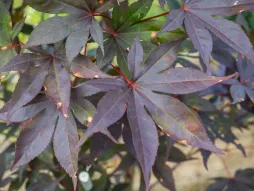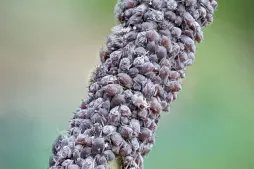Japanese maple, Acer japonicum, the king of autumn
Acer japonicum grows in China, Korea and Japan. It is undoubtedly in the Japanese archipelago that this tree of the Aceraceae family is most popular. Every autumn, during the kôyô microseason, nature lovers gather in parks to watch the Japanese maple's foliage change color.
How to recognize the Japanese maple, Acer japonicum?
In the forests of Asia, the Japanese maple is a spreading tree that reaches a height of ten meters. Its trunk, with its smooth, grey bark, measures some forty centimetres in diameter.
Acer japonicum's deciduous foliage is made up of opposite, serrated leaves seven to twelve centimetres long. Each blade has between seven and eleven lobes. Tender green in spring, the foliage turns red in autumn.
But the tree can also be admired in summer. Less spectacular than cherry blossom, the Japanese maple's blossoms are nonetheless well worth a look. In April, it is adorned with crimson flowers. These take the form of a drooping ruby-red umbel, with creamy-white stamens.
These are replaced by the fruit. These winged samaras take flight when tossed into the air. They then descend slowly, whirling like helicopters.
Botanically speaking, Acer japonicum is the true Japanese maple. But other Acer species, also native to Asia, are often presented as Japanese maples. This is particularly true of palmetto Maple. To distinguish an Acer japonicum from an Acer palmatum, count the leaf lobes. If there are no more than seven, the specimen in front of you is an Acer palmatum, not a Japanese maple.
Our maintenance tips
You don't have to be a pro to enjoy the maple's magnificent foliage. Hardy, the tree requires only a little water and rich soil.
Watering
When the soil has dried on the surface, you can water. Use non-calcareous water at room temperature, such as rainwater. If you don't have any, you can use tap water that you've left to stand.
Drain off any water that collects in the planter or dish. It can rot the roots.
Spray
Spray foliage with non-calcareous water at room temperature. Fogging helps improve humidity, clean leaves and control pests.
Repotting
Every spring, repot your Acer japonicum to give it more space.
Choose a pierced pot with a diameter slightly larger than the root ball. Plastic or PVC containers are preferable to terracotta ones: they retain moisture and resist frost.
Place a bed of clay balls at the bottom to improve drainage. Add a rich, draining potting soil, such as a mixture of heather, garden soil and vermiculite or pozzolan.
Place your shrub in the center of the hole. Its root ball should be level with the rim of the pot. Fill in with the substrate, without burying the crown. Pack down and water immediately after repotting. The water eliminates air pockets and encourages rooting.
Mulch the base to keep the soil cool.
Fertilization
To promote the growth of your Acer japonicum, apply fertilizer in spring and summer.
Between two repottings, you can apply a special maple or slow-release fertilizer.
Prune
Using clean, sharp pruning shears, remove dead branches. Then apply a healing putty to prevent the onset of disease.
Plantation
Select a bright, wind-sheltered plot. Ideal? Under a south-facing wall. Your plant will enjoy good exposure and be protected from the gusts that tear its leaves.
Soak the root ball in water to hydrate the root system and facilitate establishment.
Meanwhile, dig a hole two or three times as wide and deeper than the root ball.
Pour in gravel or clay balls to improve drainage and a layer of compost to enrich the soil.
Plant your specimen in the center. The collar should be level with the ground. Fill in with a mixture of garden soil, potting compost and sand. Tamp and water for the first time.
To protect your Acer japonicum from the cold, you can mulch the base.
Seedling
Collect seeds from a tree. You can use them with or without the winged part.
In a transparent box or airtight bag, such as a freezer bag, mix damp sand with the seeds. The seeds should be covered by the sand.
Seeds need cold to germinate. Expose them to a temperature of 1 to 5 degrees for 90 to 120 days. Your fridge will do just fine. Check for roots. Once you've spotted a seedling, carefully remove it without breaking the root. You can use a pencil or chopstick to do this. Return the can to the fridge to allow the other achenes to germinate.
Diseases / Threats
Information
| Family | Aceraceae - Aceraceae |
| Type | Maple - Acer |
| Species | Japanese maple - Acer japonicum |
| Lifecycle | Perennial |
| Foliage | Deciduous |
| Exposure | |
| Substrats | |
| Planting methods |
Open ground In pots In tubs |
| Categories | |
| Tags |
Beginner Rustic |
| Origin |
East Asia |
| Hardiness (USDA) | 7b |
| Leaf color |
|
| Flower color |
|
| Fruit color |
|
Discover plants from the same family

Mountain maple
Discover




















